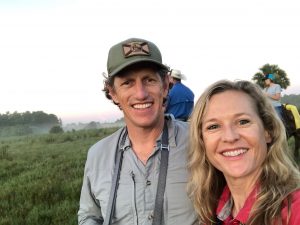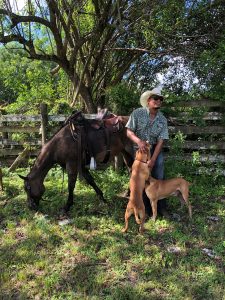A swollen and crisp full moon hangs above the horizon, casting a silvery glow over the dew-soaked grasses and palmettos. The clock shows barely 6 a.m., yet the cowboys, mounted on their horses, have already been awake for hours. They’re dressed in heavy denim, button-down shirts, and the requisite cowboy hats. They have a long day ahead of them and there are only a few short hours before the temperature cracks 90 degrees.

The group of about eight riders, many of them from the Seminole tribe, scan the landscape of cypress swamps, improved pasture, tall grasses, and fluffy dog fennel. Today, they’ll be rounding up herds of female cattle and their calves on several ranches within the Big Cypress Indian Reserve. On this early summer morning, I’m here to learn. I accompany renowned conservation photographer, Carlton Ward Jr. Ward as he documents the role of ranches in maintaining landscape connectivity for native wildlife. As part of his ongoing quest to document the plight of the Florida panther, Ward is hoping to show the human side of conservation, particularly the legacy of the Seminole and other tribes that have stewarded these lands for generations.
As a vegetarian or pescatarian since the age of 17, I have a conflicted relationship with cattle ranching. I, like many transplanted Floridians, was unaware of its long and rich history in our state. For my first decade here, I kept to the beaches and coasts, as many of us do. Without a reason to explore the sandy ridgelines and open interiors, I scarcely knew they existed, let alone appreciated their importance to our state’s economy and ecology.
The moonlit morning feels majestic and even the cattlemen pause to take it in. The group divides into pairs or ride solo, fanning out methodically alongside cur cattle dogs, all with an understanding of their roles and responsibilities. Carlton and I follow a seasoned cattleman and a young teenage female rider; they periodically glance back, indicating to come closer or stay where we are.
The herd of cattle has sought refuge in a cypress dome and as the cattlemen approach, a whip is flicked, making the iconic “cracker” sound. It’s louder than I expected and the staccato sound hangs in the air. As the dogs enter the cypress, I hear their yips and barks as well as the commotion of massive bovine splashing through the swamp. A few dozen cattle emerge from the brush, encircled by the dogs and quickly trailed by the horses. As the cattle high-tail it throughout the pasture, the dogs and cattlemen maintain a tight boundary and eventually direct the cattle to a series of pens where they will be separated into those that will be sold and those that will stay. Young calves will be sent to feedlots in other states, while the moms return to breed again in January.
Fifteen cattle were not found on this first round. After visiting a neighboring property, we return with reinforcements. The crew has nearly doubled and it feels like the A-team has been called back onto the field. The group includes a few more youths – likely the sons, daughters or friends of the seasoned cattlemen. A few men gently rib one of the youngsters after he almost fell off his horse, and as I observe the dynamic of the riders, horses, and dogs, I see the sharing of wisdom – most of it unspoken.

As the noonday sun rises above, the stakes are heightened to find the last of the crafty cattle. Beyond the foliage, a flash of a horse and rider is followed by rustling and barking. All of a sudden, a gigantic steer with a healthy rack of horns emerges from the grove. The chase begins, traversing across the landscape, bringing the posse closer to the property line and then back into the open landscape. Keeping our distance, Carlton and I track along with a young rider. The arc of a rope can be seen cutting across the sky as the dark clouds harken an oncoming storm. They must act fast. The real-life rodeo comes alive and it’s clear that every second and every movement is critical to both the safety of the animals and riders. The massive steer is swiftly roped, brought down, legs tied, and ready to be trailered later.
Just a few hours on the ranch provides me with a new appreciation for the skill and instinct of those that are so intimately connected to the landscape. For years, I’ve worked to protect theses ranches, through increased conservation funding and the halting of the asphalt, rooftops, and St. Augustine grass that will ultimately be their undoing. Now I am even more committed to their protection. Cattle ranches and other large agricultural areas are critical to keeping the patchwork of lands and waters intact. They provide vital connections between publicly-owned lands and, when managed well and protected with conservation easements, are one of the most fiscally and environmentally sound ways to protect the future of our state. Wide-ranging wildlife like the Florida panther and Florida black bear rely on them for habitat or as transportation corridors.
If we lose these ranches, we will lose our identity.
The proposed new toll roads will criss-cross many of these ranches like a wayward razor, irrevocably changing the landscape forever. The promise of a pay-out will be too much for some farmers and ranchers to pass up, as beef and citrus commodity prices have dropped across the board. Owning and managing a ranch is by no means an easy job and I believe that many do it because of a greater calling and a connection to the land and to their history. Yet, without adequate and secure funding for easements through programs like the Rural and Family Land Protection Program, selling their properties may be these ranchers’ only option.
Ranches help preserve what makes Florida sacred: our places and people. They are some of the last remaining pieces of the Old Florida. These wide-open spaces and sprawling habitats preserve a Florida where tradition runs deep and stewardship comes first. By conserving land, we conserve our way of life. Florida is like no other place on earth, and I will fight to keep it that way.









